Putaway 101: Everything in its Place
After receiving determines what and how much, it’s time to figure out where and how it should go into storage.
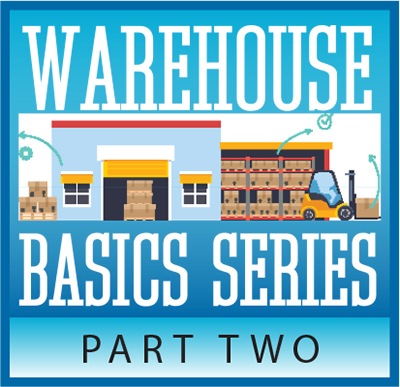
In the first article of the Warehouse Basics series, we received goods, unitized them to fit storage locations, and staged them for putaway. After goods are received and you know what you have, three general process rules apply from that point: goods will head to a pre-process buffer, an in-process buffer or a post-process buffer.
Warehouse Basics is a five-part series in which Modern unpacks the essential elements of functional areas in the warehouse. The first entry in the series was focused on receiving, and we’ll now explore putaway. The remaining entries in the series will cover replenishment, packing and shipping, and picking. Informed by industry experts, these articles are intended to capture a snapshot of the current state of materials handling practices.
For a crossdock operation, goods might instead move directly to an outbound process. Take for example a 50-store wave on a 500-store service base with only 10% true crossdock, meaning a receptacle is waiting for goods in shipping at the time they arrive at receiving. Anything that can’t be truly crossdocked has to go into a storage buffer.
There are three kinds of buffer:
- Pre-process buffer or conventional storage: Here, goods that are not allocated are stored on shelves, racks or the floor, waiting for demand. From there, they might head to a pick area or right onto a truck if shipping full pallets.
- In-process buffer: Items are pulled from receiving and sent to a pick wall, for example, to fill against orders. If goods are identified upon receipt—or even beforehand—they can be inducted onto a conveyor or allocated to a store. Case flow storage is sometimes called an in-process buffer, even though it hasn’t been allocated. If cases need to be broken case, they can go directly to case flow rack, saving the step of going to reserve—provided software systems support that functionality. If not, the additional step means older software systems can drive labor into the operation when they’re supposed to be saving it. In-process buffers are relatively infrequent because they turn very rapidly.
- Post-process buffer: Returning to the example of 500 stores, if a facility is only shipping 50 at a time, inbound goods can still be allocated to store demand—whether a store is currently being loaded or not. You might then pick to all 500 stores, and route the demand for 450 into store-specific buffers waiting for each store to become live at the dock. The simplest version of a post-process buffer is outbound ship staging.
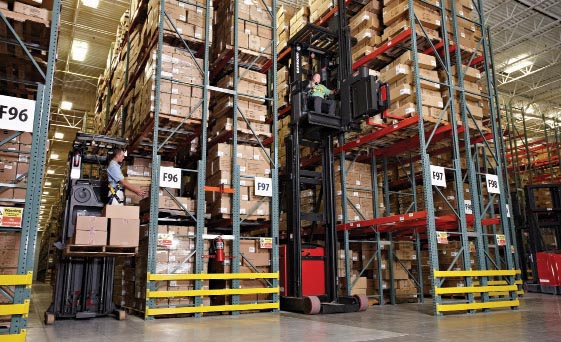
As the only option requiring putaway to storage, the pre-process buffer is the focus of this story. The most sophisticated solutions in this area can be defined as pure automated storage and retrieval systems (AS/RS). A pallet, carton or tote is delivered to the system, which stores and later presents those goods to a point of use. This might include the use of cranes, mini-load systems, carousels, multi-shuttles, and any combination of automated systems.
Most facilities use directed putaway for this step. Basic directed putaway begins when an operator approaches a load and uses a machine-readable device. This is most often a bar code, but might include RFID or manual entry if there are no scanning capabilities. The locator portion of the warehouse management system (WMS) now knows what the operator is about to put away. The locator system, based on configuration, will then direct to one or more zones. Some zone examples:
- Product to be picked in a pick module is stored in aisles close to the module,
- Product that is never replenished is directed to a full pallet area close to the dock, or
- Product destined for case pick will be put away based on velocity, so fast-movers are in easily accessible locations and slow-movers are higher in the air.
Before sending the operator on his or her way, the system can also verify the correct equipment is being used. If an orderpicker operator scans a unit load pallet, the system will indicate an error. The same goes for a reach truck that tries to handle a mixed-carton pallet meant for hand putaway.
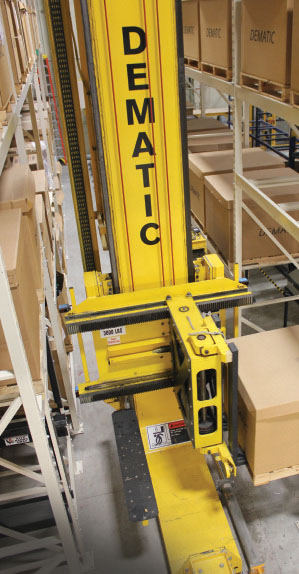 Most importantly, the locator system software knows a few pieces of information that are essential to good directed putaway: where the item is already stored; what locations are available; and the location that will ensure the best productivity when the product comes out of storage.
Most importantly, the locator system software knows a few pieces of information that are essential to good directed putaway: where the item is already stored; what locations are available; and the location that will ensure the best productivity when the product comes out of storage.
Beyond the fundamentals, any number of considerations can help determine the best open location, and those factors will be different for different operations. Some need to ensure first in, first out (FIFO), or an operator tasked with putting away a mixed-case pallet might be directed in the most efficient path. In fact, some of the better systems are set up to instruct the receiver to configure a mixed-case load so that the last case is on the bottom.
Now product is located for the most part, be that in full pallet quantities of different heights, single-deep selective putaway or bulk multi-deep lanes, or pushback rack. The locator system knows the capacities of those locations, so that a pallet will be directed to a five-deep lane with one empty space. Without that functionality, that lane might stay 20% underutilized, and the full pallet might go to a new lane that is now 80% empty.
This is simple enough for nonperishable single SKUs, but if an operation has to maintain lot control or hard FIFO, the storage method and how the system manages locations must be taken into account. Unless the location is flow-through rack where FIFO is by default, the system will effectively treat a different lot like a different SKU. Customers also often prefer to be shipped a SKU from just one lot when possible.
If handling lot-sensitive products, the locator maintains them separately. The better locator systems will help manage the expiration date for each lot, and will provide alerts for product nearing expiration or quarantine it after. Again, customers will often set minimum thresholds for remaining shelf life, and will not accept lot shipments with less than, say, two weeks left. Having referenced the locator system, the order system will then drop only to lots meeting the criteria.
The locate motive
Very small or low-activity operations might work more like a stockroom, where items are stored sequentially and item No. 1 is always next to item No. 2 and so on. If a location is full, the operator will have to find another place to put goods away. The cardex system—one of the original non-computerized locator systems based on inventory transaction file cards—can direct an operator to all SKU locations and their quantities, and the operator can update the SKU’s card after each putaway. However, those operations with modern locators with directed putaway can disconnect the SKU from the location in which it resides.
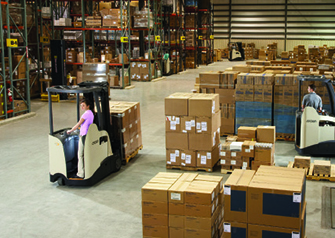
Even without directed putaway, most modern facilities at least still use a locator. The operator is free to put something away where he pleases, but that location will be logged in the system. Without directed putaway software to optimize placement, inventory management and storage utilization is heavily dependent on operator expertise and training. Locators are ubiquitous, but directed putaway is not, since it requires good pallet information and good cube information in master item files.
No locator is foolproof. When a picker is later directed to pick two cases from a location and finds only one case, there are a few potential causes. The case quantity on the pallet might have been miscounted on receipt, or a previous pick transaction was not executed properly. Modern locator functionality offers options. You might pick the remaining case to fill part of the order, or leave it there and go to a separate location for the full line requirement. Either way, the location is frozen until an inventory control clerk identifies the error, pinpoints where in the process it happened and updates the locator.
Good locator systems can help maintain inventory accuracy with “confirm zero” functionality. When a location is picked clean, the system should know and might ask the operator if the location is now empty. This acts as a kind of in-line, low-cost cycle count by confirming inventory accuracy at each stockout. Similarly, “blind count” functionality might ask an operator how many cases are left on a pallet—without offering the number it thinks is correct. If the two counts match, great. If not, the location will freeze and await an inventory administrator.
Locators that support cycle count inventory auditing can be configured in a number of ways. For a 12,500-pallet warehouse, for example, to be sure every location is counted twice within a year, divide 25,000 by 250 working days. Each day, the system will drop a cycle count list with 100 locations and send an operator to count each one. A cycle count can also be performed by SKU or by aisle. Or, it might be set up to count slow movers once a year and fast movers three times. The higher a product’s velocity, the more often it is putaway, replenished or picked, the more opportunities exist for actual inventory to fall out of sync with the system’s tally. 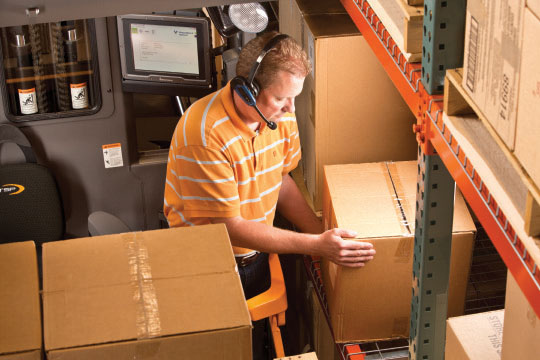
However they are configured, cycle counts eliminate the need for a year-end inventory shutdown. This is a risky proposition, since each unresolved error is an opportunity to disappoint a customer. A gradual decline in accuracy followed by a wholesale reset is also the exact opposite of consistency, which is always the best policy with inventory. In addition to ensuring service levels, consistency can help improve the operation. Errors always have a cause, and the best operations will look at the errors in their locator and storage systems, identify the root cause and eliminate it.
This story was created with generous support from Bryan Jensen, who has 34 years of experience in retail and wholesale distribution, transportation and logistics and is a principal with St. Onge Co. in York, Pa. (http://www.stonge.com). Contact Bryan at [email protected].

Article Topics
Latest in Logistics
DAT March Truckload Volume Index sees modest March gains National diesel average, for week of April 22, is down for the second straight week UPS reports first quarter earnings declines LM Podcast Series: Assessing the freight transportation and logistics markets with Tom Nightingale, AFS Logistics Investor expectations continue to influence supply chain decision-making The Next Big Steps in Supply Chain Digitalization Under-21 driver pilot program a bust with fleets as FMCSA seeks changes More LogisticsAbout the Author
Subscribe to Logistics Management Magazine

Find out what the world's most innovative companies are doing to improve productivity in their plants and distribution centers.
Start your FREE subscription today.
April 2023 Logistics Management

Latest Resources














